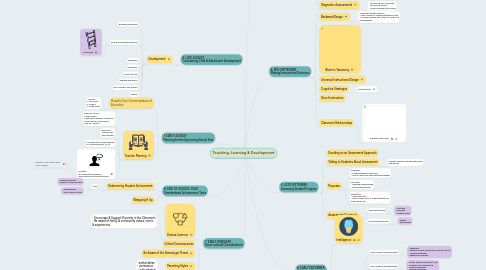
1. 1. EARLY AUGUST Planning for the Upcoming School Year
1.1. Shwab's Four Commonplaces of Education
1.1.1. 1. Teacher 2. Curriculum 3. Student 4. Environment
1.2. Teacher Planning
1.2.1. What will I teach? In what order? Using which methods & materials? In what kind of environment? How will I assess?
1.2.2. Resources: -student files -past teachers
1.2.3. "The opposite of good planning is not planning at all" (p. 19)
1.2.4. Consider: -a constructivist approach -becoming a reflective practitioner
1.2.4.1. "Learners in the Drivers Seat" -Chris Watkins
2. 2. LATE AUGUST Considering Child & Adolescent Development
2.1. Development
2.1.1. gradually progressive
2.1.2. zone of proximal development
2.1.2.1. scaffolding
2.1.3. adaptation
2.1.4. assimilation
2.1.5. innate curiosity
2.1.6. language acquisition
2.1.7. self-concept & self-esteem
2.1.8. morality
3. 7. EARLY FEBRUARY Socio-cultural Considerations
3.1. Diverse Learners
3.1.1. - Encourage & Support Diversity in the Classroom - Be aware of family & community values, norms & experiences
3.2. Critical Consciousness
3.3. Be Aware of the Stereotype Threat
3.4. Parenting Styles
3.4.1. -authoritarian - permissive - authoritative
3.5. Aboriginal Education
4. 8. END OF SCHOOL YEAR Standardized Achievement Tests
4.1. Determining Student Achievement
4.1.1. Tests
4.1.1.1. - achievement tests - criterion-referenced tests
4.1.1.2. - aptitude tests - norm-reference tests
4.2. Wrapping It Up
5. 3. FIRST WEEK OF SCHOOL Establishing a Positive Learning Environment
5.1. Getting to know your students
5.2. Classroom Management
5.2.1. Setting Expectations
5.2.1.1. Collaborate!
5.2.2. Addressing Classroom Behaviours
5.3. Establishing a Growth Mindset
5.3.1. Making mistakes is how we learn!
5.4. Be Aware of Student Needs
5.4.1. - to belong & feel connected - to feel autonomous - to feel competent/successful
6. 4. MID-SEPTEMBER Making Instructional Decisions
6.1. Diagnostic Assessments
6.2. Backward Design
6.2.1. - Measures student progress - Uses a variety of ongoing assessment tools - Includes activities that connect to and build understanding
6.3. Bloom's Taxonomy
6.4. Universal Instructional Design
6.5. Cognitive Strategies
6.5.1. Metacognition
6.6. Direct Instruction
6.7. Classroom Relationships
6.7.1. Building a community
7. 5. LATE SEPTEMBER Assessing Student Progress
7.1. Deciding on an Assessment Approach
7.2. Talking to Students About Assessment
7.2.1. Students should know what their being assessed on
7.3. Purposes
7.3.1. Diagnostic - completed before instruction - used to refine and adjust teaching methods
7.3.2. Formative - checking understanding - accumulating grades
7.3.3. Summative - after instruction - checks overall level of understanding of an instructional unit
7.4. Assessment Questions
7.4.1. Selected Response
7.4.1.1. - true/false - matching - multiple choice
7.4.2. Constructed Response
7.4.2.1. - essays - short answer
8. 6. EARLY DECEMBER Individual Differences
8.1. Intelligence
8.2. Special Education
8.2.1. High-incidence exceptionalities
8.2.1.1. - Giftedness - Attention Deficit Hyperactive Disorder (ADHD) - Learning Disabilities - Behavioural Disorders
8.2.2. Low-incidence exceptionalities
8.2.2.1. - Autism Spectrum Disorder (ASD) - Hearing/Visual Impairments - Health Impairments - Multiple Disabilities
8.2.3. Inclusion
